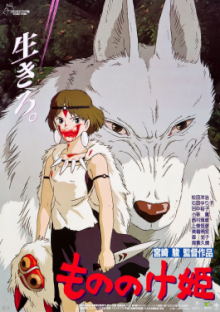As with Nausicaä of the Valley of the Wind I keep being forced to revise my opinion of the works of Hayao Miyazaki. This is another extremely violent title, complete with death on a large scale. The environmentalism theme is familiar but the death and violence gives the conflict real bite and it’s not obvious which side is in the right. Unusually for the genre, this film provides good reasons for both humans and the animals of the forest to have the right to live. The fights look spectacular without glorifying the violence and the art is as amazing as ever. As my wife notes, it stumbles at the end by being unwilling to fully commit to a specific vision for the future but I’d easily rank it among the best of Studio Ghibli’s works and consider it a film that is definitely intended for adults.
When a village is attacked by a giant boar turned into a demon, their Prince Ashitaka saves them by killing it. However he is infected by its curse which grants him superhuman strength and will eventually spread throughout his body and kill him. He travels to where the boar came from in search of a cure, his only clue being an iron ball found in the boar’s corpse. In a town, he meets Jiro, a monk who advises him to seek out the Great Forest Spirit. Elsewhere a convoy is attacked by wolves accompanied by a human girl and fends them off with primitive firearms. Ashitaka comes across two of the injured men and takes them back to their home at Iron Town. He learns that the townsfolk have been clearing trees to mine iron and are at odds with the animals of the forest led by the human San who was raised by wolves. Iron Town is led by the imperious Lady Eboshi, but she too has her good side as the town was founded to shelter and protect women rescued from brothels and lepers. When San attacks Iron Town to kill Eboshi, Ashitaka tries to stop the fighting as it will only lead to more hatred.
Despite the title, Ashitaka is the protagonist so The Boy and the Heron isn’t the only Miyazaki film with a male hero after all. He’s also clearly a young adult rather than a child, being a skilled warrior who doesn’t flinch from killing when it’s necessary. The overt violence is shocking in how graphic it is. The countless wriggling tendrils of the demon would be nightmare material for children, Ashitaka is shown lopping off the heads and limbs of enemy samurai. Large scale battles result in scores of dead animals and humans. This is a film that really doesn’t hold back, even in introducing the women working in the forges of Iron Town as former sex workers and the ones making firearms as ostracized lepers. The animals shown here are never cute. They are feral beasts more than happy to tear out the throats of humans and eat their flesh. The art looks beautiful, yet at the same time is firmly grounded in the real world. This looks and feels like the medieval Japan it is meant to be, when war and conflict are commonplace and early industrialization is changing the landscape. I was surprised that even the Emishi people Ashitaka is supposed to come from are real, being an ethnic group considered by other Japanese to be hairy barbarians.
Miyazaki’s love of the natural environment is well established and the veneration of the Great Forest Spirit here at first looks like more of the same. Yet this film breaks from the pattern by also showing the human perspective. Yes, Iron Town chops down trees to mine iron but they need it to protect themselves from oppressive samurai. San insists that she is a wolf but Ashitaka keeps reminding her that she is human. The animals all ask why the all powerful Great Forest Spirit refuses to take action against the humans while the apes want to consume human flesh to gain their strength. This is a grim take on the conflict between civilization and nature that unusually for the genre isn’t squarely on the nature side of things. The film is unable to offer any definitive solution but I like the suggestion that the humans have a right to their way of life as well and perhaps it is time for nature to give way. The hope is that humanity will be able to strike some sort of balance to leave some space for the forests and the animals but it treats the fact that human civilization is in the ascendant as an inescapable fact.
This messaging would have been more effective if Miyazaki had been able to resist the urge to add a final concession to the nature spirits and make this more into a lament about the passing of the magical age of wonders. As it is, I’d still rate this highly as one of the rare takes on environmentalism that isn’t all sunshine and rainbows. I suppose like anyone else Miyazaki has more facets to him than is immediately evident and he is capable of telling stories with a harder edge if he wants to.
